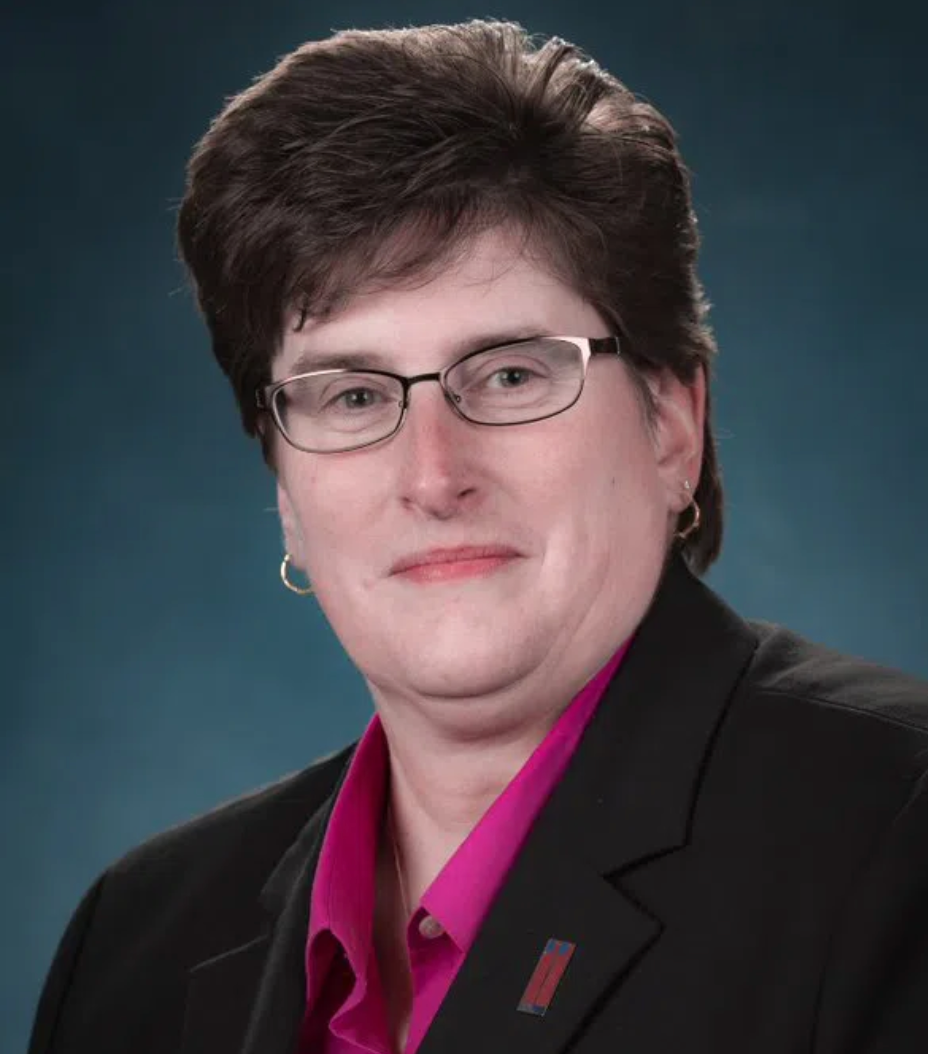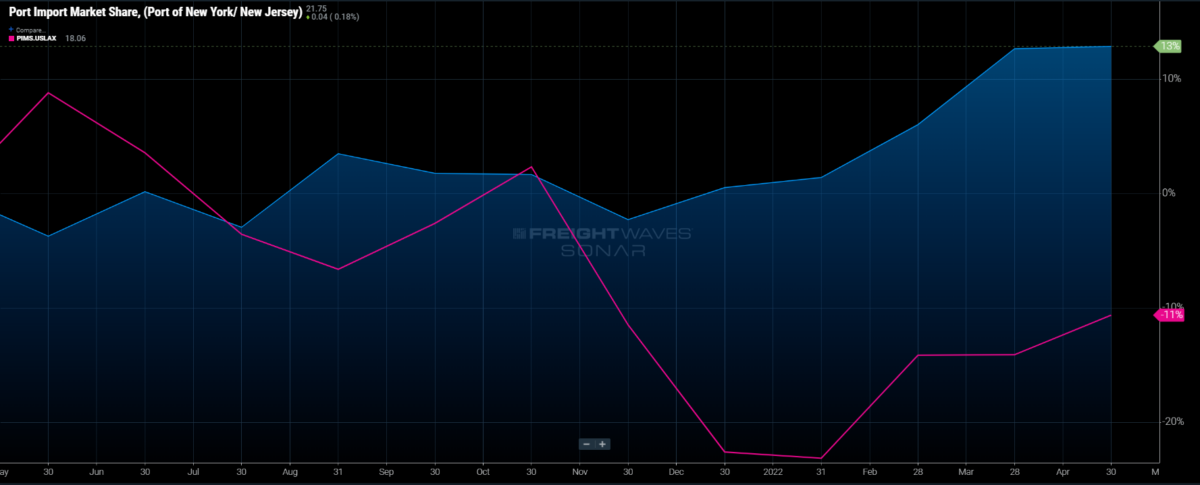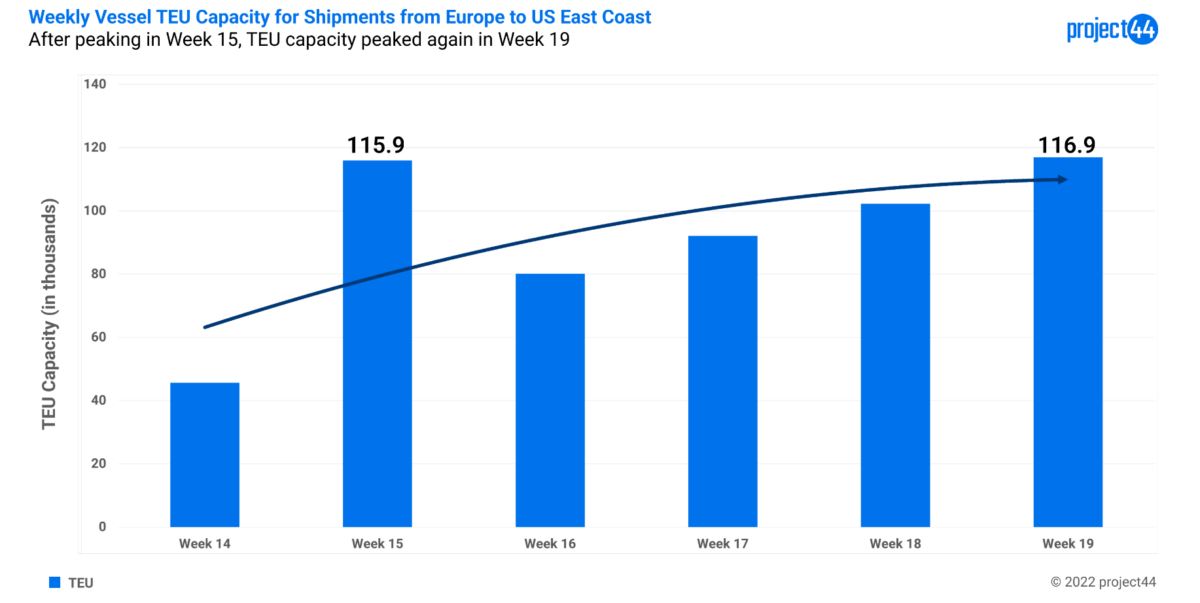The East Coast ports have become a big winner in the trade game as more logistics managers diversify away from the West Coast. The Port of New York and New Jersey is just one of the ports reaping the benefits of this container migration.
American Shipper recently spoke with outgoing Port Director Sam Ruda and successor Bethann Rooney on their assessment of these historic times and how Rooney will continue to bring all stakeholders together.
Port Master Plan impact
AMERICAN SHIPPER: Both of you have overseen the development and implementation of the Port Master Plan — a 30-year strategy set to guide the port’s growth and manage the expected increase in cargo volumes. Given the historic volumes of containers, how many years did this propel you in the plan?

SAM RUDA: “From a cargo demand and capacity perspective, the cargo volume increase over the last two-plus years has propelled the seaport about five to six years forward. Just isolating capacity, we need to be mindful that effective capacity has a number of moving parts.
“One important component of that is the current high-volume period has also come with sharp increases in dwell time of containers, both empty and full. This is not a development that you can plan for. To the degree that cargo volume remains elevated, capacity can be increased through corresponding decreases in box dwell.
“The supply chain, at least at present, remains in flux, and while there are early signs of a trend toward reduced dwell, it has not happened yet. Short term, this is where capacity gains can be found.”
BETHANN ROONEY: “In 2021, the seaport handled just shy of 9 million TEUs. The Port Master Plan 2050’s container forecast includes a high and a low forecast depending on whether our strategy is to focus predominantly on our local cargo market (low end — 12 million TEUs by 2050) or to push to maximize our share of the discretionary market in addition to the local market (high end — 17 million TEUs by 2050).
“During the master planning process, the Port Authority decided to develop the plan around maximizing our local share and capturing a moderate share of the discretionary market (14 million-15 million by 2050).
“With that in mind, in 2021 the Port of New York and New Jersey handled the cargo volume that had not been anticipated by the plan until closer to 2027. That meant seven years of growth without any time for the supply chain to prepare and make the investment in the links of that chain, from additional trucks, chassis and warehouse capacity to additional personnel resources to new operating models such as additional hours of service.”
Predictive trade platforms
AMERICAN SHIPPER: The paradigm shift in e-commerce has catapulted digital logistics, some say, by 10 years. Is there a need for more predictive trade platforms to quantify the anticipated amount of trade coming in?
RUDA: “Data is indeed king. But good data is emperor (or empress). The key here is that a lot of stakeholders in the supply chain require different data sets. But the data needs to be accessible and customizable with fewer discrete platforms.
“Technology is less of the issue. What needs to occur is that data dashboards need to be utilized in a way that drives more collective decision-making beyond individual or modal silos. A good portion of the data exists. It’s just not being efficiently deployed and used to drive collective decision-making.”

ROONEY: “There is power in data that collectively we need to harness. For some supply chain stakeholders, data is nothing more than information and transparency. To them, it is: ‘Where is my cargo and is it available for pickup?’
“We need to go beyond that.
“The true power that the data holds is in being able to use that information, the data, to improve planning and resource allocation. Dozens of predictive analytics scenarios, depending on where you sit in the supply chain, exist for how data can be leveraged to help optimize resources and provide vastly improved information and transparency.
“For example, one question that data might be able to answer is, ‘When is the most probable time to schedule my trucker to pick up the container based on the location of my container on the ship and historical crane productivity?’
“One scenario related to the discretionary market that we have discussed is, for example, using manifest information when the ship sails from the last foreign port to extract the volume of IPI containers by railroad and destination and providing that information to the Class I railroads well in advance of the vessel’s arrival, so that the railroads can plan the number of empty rail cars that will be needed and have them already spotted in the Port of New York and New Jersey when the vessel arrives.”
Council on Port Performance
AMERICAN SHIPPER: Sam, the Port of New York and New Jersey, along with other ports across the nation, have had double-digit growth. Despite being a landlord port, you have not seen the problems the Ports of Los Angeles and Long Beach have seen with the stakeholders not working as one for efficient trade flow. What has the Port of New York and New Jersey along with their stakeholders done to be so united? Is it the Council on Port Performance?
RUDA: “At nearly 9 million TEUs, cargo volume through the Port of New York and New Jersey comes with its own set of challenges. This is especially true when you are experiencing a global pandemic. Nevertheless, what works well here is that we have strong leadership across the supply chain stakeholders and modal providers. This includes the ILA (labor), the railroads (Conrail, NS and CSX), the NYSA, as well as the terminal operators, trucking industry, equipment providers and depot operators, to name a few.
“There is a long history of the Port Authority of New York and New Jersey playing an active role as a convenor. We did not need to create a new forum to deal with the pandemic.
“The Council on Port Performance has been in existence since 2014 and includes 18 different sectors of the supply chain. The only thing we changed was the frequency of the meetings, which moved to weekly for the first year of the pandemic.
“As cargo volumes rebounded, however, we identified the need for a more narrowly focused stakeholder forum which included the terminal and depot operators, trucking, equipment providers, rail, and labor, which met on a biweekly basis. It is really important to have a common platform for sharing and reacting to real-time information. This is the tradition at the Port of NY and NJ, and it is a major reason for our collective success.
“As a final note on this, the seaport also has a productive and ongoing engagement with our federal partners. More specifically, the Coast Guard, the Army Corps of Engineers, Customs and Border Protection and the Maritime Administration. There are so many moving parts to efficient cargo movement. But our federal partners are real partners and we work very closely with them.”
Watch: Lori Ann LaRocco interviews Sam Ruda
AMERICAN SHIPPER: Beth, you are the architect of this council. Can you talk more about the performance, efficiency imperatives as well as the environmental sustainability measures you and the stakeholders are working on?
ROONEY: “First, it is important to recognize that the council is set up to work in an advisory capacity only. The council does not have the authority to require or enforce the adoption of recommendations by individual stakeholders. The council’s bylaws cite that ‘the Council on Port Performance (CPP) functions in an advisory capacity to provide advice, counsel and recommendations on matters relating to improved efficiency and service reliability in the Port of New York and New Jersey.’
“I believe that the most significant accomplishment of the CPP, dating back to its founding, is the recognition by all stakeholder segments that if one part of the supply chain is not performing well, the entire supply chain — upstream and downstream — is affected.
“The CPP helped break down the traditional silos wherein each segment was focused on their performance only to the point of recognition that an issue in one link could affect the rest of the chain (and its ability to make money). Having a forum for entities that do not have a formal business relationship to collaborate, communicate and coordinate allows each entity/segment to consider the upstream and downstream effects of a business decision that was traditionally made with blinders on.
“Now, decisions in one sector are made with a more holistic view of the entire gateway and with an understanding that when one segment does well, they all do well. Everyone is on the same team working for the good of the whole.
“That is not to say that all decisions made by individual sectors or entities are always welcomed by the other sectors and that there is never any conflict, but there is at least a dialogue in advance and consideration given to the rest of the supply chain.
“Currently, the council is focused on two key issues: 1) Long-dwelling imports and the need to have them removed from the container terminals to off terminal container yards, and 2) the evacuation of empty containers and the availability of empty container return locations.
“While the CPP does not address sustainability explicitly, improvements to efficiency and service reliability will have a positive impact on sustainability.”
Looking back and looking ahead
AMERICAN SHIPPER: Sam, you have worked at the Port of New York and New Jersey since 2015. What would you consider your biggest accomplishment?
RUDA: “The first is that the Port Department staff at the Port Authority is as engaged with our tenants as we have ever been. And this, in turn, develops into a productive two-way dialogue that collectively moves the needle in the right direction.
“The second accomplishment is leading the seaport through the COVID pandemic. As an industry that was deemed ‘essential’ for all the right reasons, keeping the cargo moving was key. But of higher importance was keeping the cargo moving while also keeping the front-line workers safe and healthy.
“Very early in the pandemic, I was not going to allow this port to be at the mercy of PPE handouts. We developed our own supply lines, and it was a shared and collaborative effort.”

AMERICAN SHIPPER: Beth, are you expecting in the coming months more TEUs coming your way as a result of logistics managers choosing the East Coast in an effort to circumvent any disruption or slowdown because of the ILWU negotiations?
ROONEY: “All indications are that we have been and will continue to see containers that would have otherwise moved over to the West Coast, but in fear of the ILWU negotiations, have shifted their volume to our seaport (and other U.S. East Coast ports).
“It is nearly impossible to accurately forecast the volume that is expected to shift to the East Coast, but in conversations with ocean carriers, shippers and beneficial cargo owners, the shift appears to be more proactive than was experienced in the early phase of the last set of ILWU negotiations.
“We have heard several examples of shippers who typically transport their products that originate in Asia through San Pedro Bay ports to warehouses in or around the central coast of California. They are now using the all-water route to our port and then land-bridging back to California, which is currently faster, cheaper and more reliable.”

AMERICAN SHIPPER: Multiple logistics providers in Europe are concerned the shipping delays coupled with the blank sailings has eaten into the supply of empty containers. What is your outlook as we navigate this uncertainty all stemming from “zero COVID”?
ROONEY: “There is no shortage of empty containers needed to support the Port of New York and New Jersey’s export market. We are encouraging the ocean carriers to deploy sweeper vessels to evacuate large numbers of empty containers. Sending the empties to Europe rather than back to Asia would benefit the Port of New York and New Jersey, particularly if the sweeper vessels can immediately return for a subsequent voyage to pick up the next group of empties.”
AMERICAN SHIPPER: The high freight rate has attracted five new entrants that are not engaging in reciprocal trade. Bal Shipping only transported 45 loaded U.S. exports last year. All the other entrants, including the Alibaba-backed Transfar, did not fill their vessels with loaded U.S. exports. Have you spoken with Transportation Secretary Pete Buttigieg on these new entrants?

ROONEY: “Of the new entrants, the Port of New York and New Jersey has only seen activity from three of five new entrants: Transfar, X-Press and Lihua. The first one didn’t start to call our port until August 2021.
“Given that these carriers entered the U.S. market to help pick up the extra inbound volume, it is not surprising that they did not fill their vessels with loaded exports. I believe there are a variety of reasons for that, including that the U.S. exports had service contracts with other carriers.
“Given the entrance late in the year, time is also needed for the containers to cycle through and be available for export. From August 2021 through March 2022, those three carriers have imported just 5,208 TEUs into the Port of New York & New Jersey. During that same time, those three carriers have exported 2,049 TEUs or 40% of the import volume — dramatically more than in other U.S. ports.”
China and the eventual surge in containers
AMERICAN SHIPPER: How concerned are you about China’s “zero-COVID” policies and the anticipated surge in containers that will follow?
ROONEY: “Undoubtedly we will experience a hockey stick-style surge beginning approximately six to eight weeks after the reopening in China. Import containers originating in China represent 29.6% of our total imports, which pales in comparison to the China market share in the combined Ports of Los Angeles and Long Beach, where it is more than twice as much.
“Hence, the effect will not be as significant here as it will be on the West Coast. Nonetheless, if we are unable to reduce the amount of long-dwelling imports and empties in the next several weeks, the surge will be very difficult to handle.”
Bubbles and thinking big
AMERICAN SHIPPER: The ports around the world work in bubbles. The World Bank and the United Nations Conference on Trade and Development have spoken about the need for global customs, a more transparent digital platform for more efficient trade. How can these multitude of bubbles pop in order to achieve data sharing so trade can be tracked, traced and moved efficiently?
RUDA: “I remember something that the late Bruce Seaton (former head of American President Lines) said about this industry. I am paraphrasing here, but he effectively said that the shipping industry is about efficient handoffs of the cargo (the container).
“While the industry was born right here at Port Newark, it has evolved in ways that ensure less efficiency in these cargo handoffs. This, ultimately, is the core problem that needs to be solved. Anything that simplifies, adds speed, reduces duplication of effort will add value toward streamlining this age-old bubble issue.”
ROONEY: “The concept of a centralized information system for global trade gives me great cause for concern. While technology and data platforms have the potential to help improve transparency and efficiency, those incremental benefits need to be carefully weighed against the risks of cybersecurity — namely data protection and the associated confidential and proprietary information that could be compromised.”
AMERICAN SHIPPER: Sam, how does the U.S. tackle its own bubbles?
RUDA: “I recently hosted a Q&A with Secretary of Transportation Buttigieg in Washington. …. I asked the secretary what he would like to see from U.S. ports. His answer was spot-on. He said, ‘Think big.’ Old problems require new solutions. And this is what makes this industry so interesting and fascinating.”











